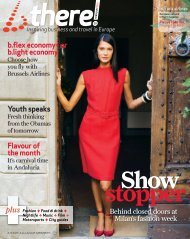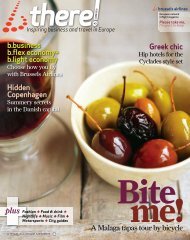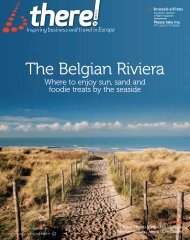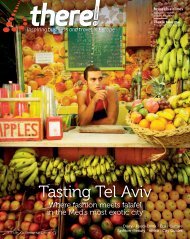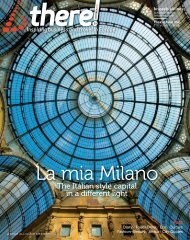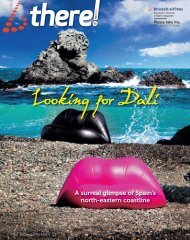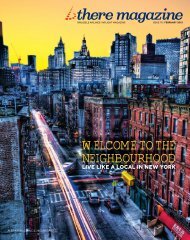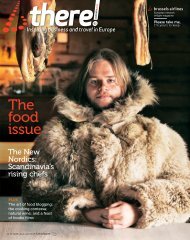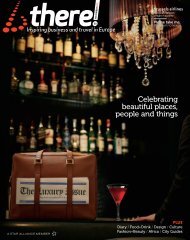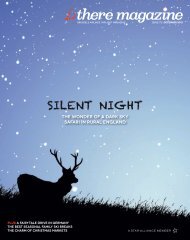november-2012
november-2012
november-2012
You also want an ePaper? Increase the reach of your titles
YUMPU automatically turns print PDFs into web optimized ePapers that Google loves.
LUXURY VENICE<br />
frontages held up by columns, light and<br />
airy rooms – that has dominated European<br />
architecture ever since. From London to<br />
Leipzig, Porto to St Petersburg, step into any<br />
elegant street and you can see his influence.<br />
Born in 1508 to a lowly gondola-maker,<br />
Palladio established his career building<br />
large country villas for noble families on<br />
the mainland of the Veneto region that<br />
surrounds Venice. As his reputation grew,<br />
he was commissioned to produce churches<br />
and public buildings scattered through the<br />
city of Venice itself.<br />
And since a tour of his works takes in not<br />
just a journey through architectural history,<br />
but also through the atmosphere of<br />
renaissance Italy – a time of pleasure and<br />
decadence (not to mention intrigue and<br />
danger) – it is doubly hard to resist. So<br />
here I am, suspended above the rose<br />
petals, while my masseuse, Angela, gently<br />
rubs lavender oil into my temples, the only<br />
sounds the same songs of birds that Palladio<br />
would have heard 500 years ago as he sat<br />
on this site dreaming of what he could build.<br />
An hour later, rose-scented and relaxed,<br />
I gaze up at the Zitelle church, which<br />
displays Palladio’s passion for the beauty<br />
of the simple straight line and the gentle<br />
curve. It is a strong work, but not his<br />
masterpiece. The architect’s finest church<br />
was the neighbouring Church of the<br />
Redeemer, just a few steps away, and built<br />
in 1577 to give thanks to God for saving two<br />
thirds of the city’s population from the<br />
bubonic plague that had raged that year.<br />
The front of the church displays all of<br />
Palladio’s trademarks: a square design that<br />
imposes strength; classical columns to<br />
unite the building with Rome’s majestic<br />
history; steps reaching up to the entrance<br />
that signify the road to heaven is not easy.<br />
It really is no coincidence that Venice was<br />
known as The Serene Republic in an era<br />
when Palladio’s vision of quiet strength<br />
was at its very heart.<br />
Stepping through the door can surprise<br />
many a visitor used to the ornate churches<br />
of Rome, because it is simple, mostly white<br />
and very light inside. Palladio was a pious<br />
man who did not approve of excessive<br />
palladio was<br />
a revolutionary,<br />
a dreamer of rome<br />
and a prophet of<br />
modernity<br />
decoration (and preferred it if people<br />
marvelled at his architecture rather than<br />
some hack painter’s fresco). But there are<br />
curiosities too – no visitors should miss the<br />
church’s rather bizarre collection of wax<br />
effigies of the heads of former chief monks,<br />
kept in glass jars in a room behind the altar;<br />
a sort of freaky ecclesiastical version of<br />
Madame Tussauds.<br />
A water-taxi hop over to the main island<br />
takes me to St Mark’s Square, the heart of<br />
Venice. Palladio would no doubt have<br />
walked the same paving slabs, perhaps<br />
stopping for a glass of wine or two.<br />
Determined to get under the skin of a<br />
renaissance nobleman, I stop off at the<br />
finest restaurant on the square, the<br />
Michelin-starred Ristorante Quadri, which<br />
produces classical Italian cuisine just as<br />
Palladio would have eaten on the same<br />
spot half a millennium ago.<br />
An hour away by train is the town of<br />
Vicenza, where Palladio was based for the<br />
early years of his career and is therefore<br />
Top: Ristorante Quadri on St Mark’s Square, where<br />
Palladio himself once dined. Bottom left and right:<br />
the opulent Hotel Bauer Palladio is the former<br />
convent of the Italian architect’s Zitelle Church<br />
Previous page, from main image: The Doge’s Palace,<br />
St Mark’s Square; the Church of The Redeemer on<br />
the Giudecca is considered Palladio’s greatest work;<br />
a statue of the architect in Vicenza<br />
Eat, sleep, pamper<br />
■ The Bauer Palladio Hotel and Spa,<br />
double rooms with breakfast, €975 per<br />
night; Vitalis bath therapy €90 for 30<br />
minutes, palladiohotelspa.com pa.com<br />
■ Eat like a doge<br />
at Ristorante Quadri<br />
(right) on St Mark’s<br />
Square: tasting menu<br />
€200, caffequadri.it<br />
■ Live in the lap of luxury at Villa<br />
Saraceno from €1,000 for three nights,<br />
landmarktrust.org.uk;<br />
villagodi.com; lamalcontenta.com<br />
46 <strong>november</strong> <strong>2012</strong><br />
FLY TO venice twice daily. brusselsairlines.com



